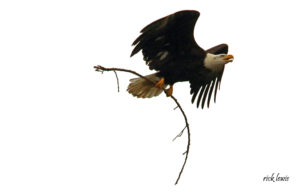We may be in the thick of winter, but birds are starting to return to town and are looking for a safe and snuggly place to raise their broods.
Many nesting birds like dead tree cavities, but our manicured tastes don’t allow much room for that kind of unsculpted habitat. So what’s a homeless bird to do?
As you settle into your own warm nest, now’s the time to plan for a bird box. There’s a thing or two that Mike Azevedo, the nest box coordinator for the Santa Clara Valley chapter of the Audubon Society, wants to share with you about how to do it right.
“If you don’t know what you are doing, you could put up a nest box that isn’t going to be used by anything but house sparrows,” said Azevedo.
No one’s knocking house sparrows per se, but there are probably other species you’d also like to see out your back window, and species that really need our help. Azevedo runs the workshop “Putting up A Successful Backyard Birdhouse,” a title he finds ironic because most bird boxes won’t be successful in a typical backyard, nor should they ever look adorned like houses.
Here’s our Five Step program to a successful bird box:
Step 1: Who’s your baby?
Decide which bird species you’d like to help. Scout out your neighborhood to find which species of birds natively nest there because you’re not going to attract a new type of bird. Some local candidates may be: western bluebird, oak titmouse, chestnut-backed chickadee, house wren, and Bewick’s wren.
Step 2: Location, location, location
Real estate is important to a nesting bird. Find a spot that works for your chosen species. Western bluebirds, for example, like grasslands. That makes Ed Levin Park in Milpitas excellent digs, and one in which Azevedo chose for caretaking. If you don’t have a good environment in your own yard, contact your nearest park, cemetery or golf course to see if you can get permission to place a bird box there. Start early on this task because some spots might require permits or make special requests.
You’ll also want to make sure predators can’t access the nests. Nest boxes do best 10 to 15 feet above ground to limit the danger of predators like cats, raccoons and snakes, which can all destroy nests.
After deciding where you would like to put your box, contact your county’s Cavity Nester Recovery Program for help with proper placement of the boxes.
Step 3: The bird box
You’ve seen the images of quaint, colorful homes so darling you wish you could move in. Wrong. Azevedo says you need to find a box that doesn’t draw attention.
“When people build it they should make it drab, because it’s been a long time since humans have had to worry about animals knowing where they live, but birds still have to worry about animals knowing where they live,” he said.
Different birds will need specific design features. Bluebirds, for example, need holes that are big enough for them to fit in, but small enough that predators have a difficult time entering. Generally, a bird box should be around 5 inches by 5 inches, nice and tight, and have small drainage holes for humidity to escape.
And forget about including a peg below the hole, which can actually be a grasping point for a predator to enter and might encourage house sparrows and starlings to enter and take over the homes. All boxes should have a contraption for well-meaning humans to enter. Side-opening boxes are best because it’s easier to count eggs and chicks inside, but top opening boxes work, too.
You can make your own bird box, or shop for one at a place like the Audubon Workshop.
Step 4: Being the landlord
You’ve set up the right bird box in the right place, and you’ve got a brood happily settled in. As the responsible landlord, your little chickees still need you. You should check your box every week to count the eggs and make sure the box is safe. If there seems to be a disturbance, you’ll want to move the bird box to a safer place. Best of all, now’s when you can take pride in your efforts.
“Every time I see a bluebird outside my office in San Jose I have a beam of pride, because I know that what I am doing is helping that bird out,” said Azevedo.
Consider being part of the research. The Santa Clara Valley Audubon Society, and other organizations, have bird nesting programs that keep data on the number of nests and population.
Step 5: Get help
There are a number of organizations set up to help you in your bird box endeavor. Santa Clara Valley Audubon Society runs training sessions, and the other Audubon chapters in the Bay Area may provide advice as well.
Alison Hawkes is the online editor for Bay Nature. Intern Samantha Juda contributed to this story.
[slideshow]




-300x221.jpg)
-300x221.jpg)